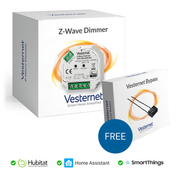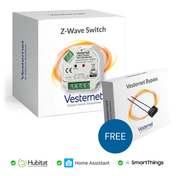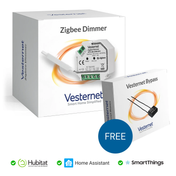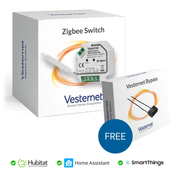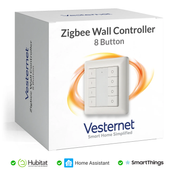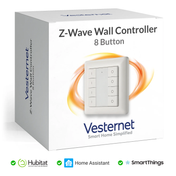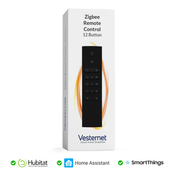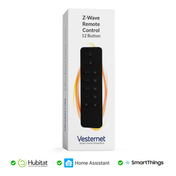
Home Automation has lots of new words and terms that can be confusing, especially if you're new to the technology.
This glossary includes all the words and terms that you'll find in the world of Home Automation and Smart Home technology.
2-Way Lighting
A lighting system where one light is controlled by two switches. For instance a hall light that can be controlled from the hall and the upstairs landing. A typical wiring scheme is shown in Application Note 2 - Using 2-way lighting
2-wire Lighting System
Lighting system that does not include neutral at the light switch. See Understanding 2-wire and 3-wire lighting systems for more information.
3-wire Lighting System
Lighting system that does include neutral at the light switch. See Understanding 2-wire and 3-wire lighting systems for more information.
Actuator
Home automation Device that switches digital (on/off for an electrical switch) or analogue signals (0 % … 100 % for a dimmer or blind control).
Application Notes
Vesternet's range of guides and tutorials showing how to use the Vesternet products - all available in the Application Notes section.
Association
The process of adding a device to a Group. By doing this, the device can be controlled as part of the group.
CFL Bulb
Stands for Compact Fluorescent Lamp - these are the 'Energy-Saving' light bulbs that we all now use in our homes. CFL's have replaced traditional (incandescent) light bulbs.
CFR Bulb
Stands for Compact Fluorescent Radio Lamp - identical to a CFL but these bulbs have a built-in radio receiver that enables them to be controlled by a wireless home automation network such as LightWaveRF.
Controller
A Device that can control other devices on the wireless network. There are a variety of controllers available including hand-held remote controls, central gateway controllers that provide access to the Internet and PC software (via USB) that can control your network from anywhere in the world.
Device
A Device is a specific electronic product that can be controlled through the wireless network. The device can be a local wireless controller, which controls a specific light or appliance (usually connected to it by mains wiring), or a sensor that provides input to the network. Each Device is seen as a network Node.
Dimmer
A wireless controlled Device that controls the brightness, as well as the On/Off state, of a local light. It will be connected to the light via standard wiring.
Dual-Mesh Network
Network system used by INSTEON. Control signals are simultaneously sent using your home’s mains wiring (powerline) and the INSTEON wireless network. At the same time all INSTEON devices act as repeaters ensuring signals get to the furthest reaches of your home - without dead-spots.
Ethernet
Common system to create a computer network using cables (wired network). This system is less common in homes, where the more convenient Wi-Fi (wireless) system is used. However, the wireless Router typically includes Ethernet sockets so that a PC or other device can be directly connected to it.
Event
A set of commands that get instigated following a trigger from a device or sensor. For instance when a motion detector is tripped a light comes on.
Exclude
To remove a Device from a wireless network. After a device is Excluded, it cannot be controlled by the network. It can be Included into the network again at any time.
Gang
Term used to say how many switches are on a switch face place. For instance if a switch has two switches that control different light circuits, this is know as a 2-gang switch.
Gateway
Connects your home automation network to the Internet. The Gateway enables you to control the network and all the devices on it from anywhere in the world using a computer or smartphone. It also enables your network to send and retrieve information from specific remotely located servers.
Groups
A collection of individual Devices, which can be controlled as a group. For instance a controller can switch them all on with one action, rather than having to turn on each Device individually.
Home Automation
All aspects of adding control to your home and appliances. It can be as simple as adding remote control to a few lights, or creating a more complex system that includes automatic sensors and security systems.
Home ID
The common identification for all Nodes belonging to one Z-Wave network. Each Controller is factory programmed with a unique Home ID, when operating as the Primary Controller, it assigns this Home ID to the network. The Home ID is 4 Bytes (32-bits) long.
Include
The process to add a Device to a wireless network. When Included, the device can be controlled by the network.
Insert
Similar to Module. An Insert is installed inside an existing wall-box to add wireless control to the appliance or light. In most instances the existing switch or dimmer can be retained for manual control.
Internet of Things
Popular term to describe how real-world sensors and appliances will be connected together via the 'cloud' enabling them to communicate and control each other wirelessly. Also know as IoT.
IP
Stands for "Internet Protocol". It is a standard set of rules for sending and receiving data across a computer network or the Internet.
Used with Ethernet and Wi-Fi networks.
IR
Stand for "Infrared". Commonly used by remote controllers to control appliances such as TVs, DVD etc. The control signals are sent using Infrared light, which is invisible to the human eye. IR is line-of-sight technology, which means there must be no obstacles between the controller and the appliance.
LED
Stands for Light Emitting Diode. These modern light bulbs use very little power - typically 10% of the traditional incandescent bulbs
LightwaveRF
A new wireless technology to control home electronics from a single wireless network. LightwaveRF is an affordable alternative to Z-Wave, ideal for creating a simple home network to control lights and home appliances. Since its launch in 2011, LightwaveRF has quickly grown to become one of Vesternet's best selling technologies. Further information is available in our Resources section.
Module
A Device that adds wireless control to a light or appliance. For instance a dimmer module enables you to control a lamp wirelessly.
Manual Override
Enables the user to control the Device locally without using the wireless network. For instance a Z-Wave socket will have a manual On/Off switch.
Mesh Network
A type of Network that allows each Device to send, receive and repeat messages. This process makes the network more robust and extends the range of the entire network. Z-Wave is a good example of a Mesh Network.
Momentary Switch
Momentary switches, also known as Retractive, Mono-Stable or Bell-Push, only remain in the On state while you press them, they return to the Off state when the button is released. These are commonly used in home automation systems.
Mood
Similar to Scene. Mood is a LightwaveRF term where one switch can control many devices at the same time, each device receiving a different command. For instance "turn lamp A off, raise the roller blind on Window C and turn the TV on".
Network
Two or more Devices connected together is called a Network. This enables Devices to be controlled and to communicate with each other. For home automation we typically refer to a Wireless Network as a Network.
Node
A specific point or Device on a home network. Each Node has a unique address, which the Controller uses to communicate and control it.
Node ID
The address of a single Z-Wave Node, the address length is 1Byte (8-bits).
Pairing
Means the same as Include - the process to add a Device to a wireless network. The network can then control the Paired device.
Portable Controller
A network controller that can be moved around the home or office. These controllers are normally hand-held and battery-powered. It’s recommended that Portable Controllers are used together with at least one Static Controller to ensure reliable network operation.
Primary Controller
This controller Includes all other Devices into the Network. It assigns its Home ID to the network and allocates a Node ID to each Device in the network (including secondary controllers).
Protocol
A set of communication rules that enable network devices to communicate with each other. INSTEON, Z-Wave , Zigbee and LightwaveRF all have their own communication protocols.
Relay
A wireless controlled Device that controls the On/Off state of a local appliance (load). The Relay controls the power going to the load via standard mains cables. The term Relay is normally associated with Inserts and Modules that control appliances of more than 600W (not lights).
RF
Stands for "Radio Frequency". All wireless technology uses RF signals to send and receive information. Home automation technologies use various Radio Frequency ranges: Z-Wave (868.42MHz EU), LightwaveRF (433.92MHz) and ZigBee (868.42MHz EU).
Router
Similar to a Gateway, a Router connects a local area network (LAN) to the Internet. In most home installations the Router controls the wired (Ethernet) and wireless (Wi-Fi) networks as well as communication with the Internet. For the purposes of this document Router is part of your computer network and Gateway is part of your home automation network.
Scenes
Like Groups, Scenes group together multiple Devices. However, while groups treat all devices similarly, scenes enable a controller to send different commands to different devices. This results in endless possibilities such as: "turn light switch off and open window B" or "dim all lamps to 50 % and turn on the TV". This ability makes Scenes a very powerful part of a modern home automation network.
Secondary Controller
An additional controller that can control Devices on a Network, however, it cannot Include devices to the network, this is performed by the Primary Controller. When the secondary controller is included into the network the primary controller assign its Home ID and Node ID.
Sensor
Home automation Device that sends information across the network based on changing conditions such as movement, temperature and light levels. For instance a motion sensor sends information when motion is detected.
Setpoint Temperature
The temperature that thermostat is set to. If the room's ambient temperature is below this setpoint temperature, the thermostat will send a signal (or close a switch) to turn on the heating system.
Slaves
A Device that is controlled by other network devices. In Z-Wave networks, slaves are categorised as “standard” or “routing” slaves. A routing slave includes advanced capabilities for routing signals around the network. Typically slaves are Actuator devices such as switches, dimmers and relays.
Static Controller
A network controller that has a fixed location. At least one Static Controller is recommended to ensure reliable network operation in Z-Wave systems.
Switch
A wireless controlled Device that controls the On/Off state of a local light (load). The Switch controls the power going to the light via standard mains cables and can be a switch paddle, Insert or Module.
Toggle Switch
Toggle (Bi-Stable) switches latch in position. For instance when you press the switch to On, the switch physically stays in the On position. These are the standard light switches you’ll find already fitted in your home.
Unpairing
Means the same Exclude - to remove a Device from a wireless network. After a device is Unpaired, it cannot be controlled by the network, but can be Paired again at any time.
Wi-Fi
Wireless network that enables computers, printers and other devices to communicate with each other and the Internet (if the Router is connected to the Internet). Wi-Fi is based on the IEEE 802.11 standard.
Wireless Network
A Network on which the Devices communicate wirelessly using radio waves (RF). Wi-Fi, LightwaveRF, Z-Wave and ZigBee are all wireless network technologies.
X10
X10 is an industry standard for carrying control signals over the domestic mains power wiring. X10 devices can replace ordinary light switches, mains outlets and pendant lamp holders; these can be controlled by keypads, radio and infrared remote controls. X10 was introduced during the 1970s and is largely being superseded by the advanced capabilities of Z-Wave and LightwaveRF.
Further information is available in our Resources section.
Z-Cloud
A cloud-based central controller for Z-Wave networks. It allows you to setup, manage and control Z-Wave Devices on your network without requiring a sophisticated Central Controller or Gateway. More information: www.en.z-wave.me
Z-Wave
A Network technology that enables all your home electronics to be controlled from a single wireless network. It's easy to install with no complicated programming and no new cables to run, yet offers sophisticated control of your network. Any Z-Wave enabled device (from multiple manufacturers) can be added to the network, and many non-Z-Wave devices can be made compatible by plugging them into a Z-Wave accessory module.
Further information is available in our Resources section.
ZigBee
An advanced wireless technology being built into home automation and smart energy devices; it is closely associated with the 'Internet of Things'. Zigbee devices are based on the IEEE 802.15 standard, however compatibility between manufacturers' products is limited.
Further information is available in our Resources section.
Vesternet is Europe's leading home automation specialist. Whatever your needs, you'll be able to find just what you're looking at Vesternet.

